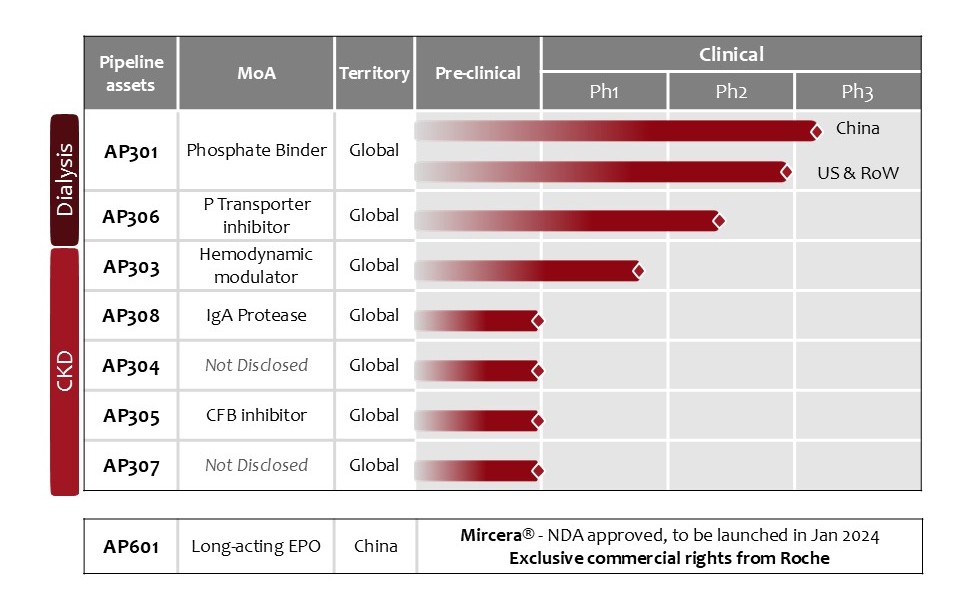Programs

Hyperphosphatemia
Hyperphosphatemia in CKD can lead to various of clinical importance such as further deterioration of kidney function, cardiovascular complications, renal osteodystrophy, and increased mortality. There is a robust association between serum phosphorous levels and all-cause mortality in dialysis patients. Hyperphosphatemia is usually managed in two ways: one is to lower the intake of phosphate in the diet, and the other is to decrease phosphate absorption in the gastrointestinal tract either by phosphate binder or by inhibiting the phosphate transport.
An ideal phosphate binder should have the following characters: high phosphate binding capacity, no systematic absorption, no influence on normal physiological environment, no imbalance of water and electrolyte, no need to chewing before swallowing, small pill burden and minimal gastrointestinal side effects. AP301 is our most advanced product, which could meet all these criteria.
IgA Nephropathy (IgAN)
IgA nephropathy is the most common form of primary glomerulonephritis globally, and it is responsible for 50% of primary glomerulonephritis in China. It’s characterized by the deposition of IgA (either alone or with IgG, IgM or both and complement) in the glomerular mesangium with cell proliferation and matrix expansion and sclerosis. Forty percent of IgA nephropathy patients develop end-stage renal disease and require dialysis within 20 years of diagnosis. No effective disease-modifying therapy is available for IgAN (current standard of care comprises ACE/ARB with short-term steroid use as necessary).
We are developing an antibody against MASP-2 (the effector enzyme of the complements lectin pathway) to treat IgA nephropathy. In a Phase 2 clinical trial, targeting on the similar pathway showed a 60% reduction of proteinuria in IgA nephropathy patients and stabilized glomerular filtration rates. Our product would have less dosing frequency than the competitor. Because the abnormal lectin pathway only accounts for about 30-40% of IgAN patients, and we are also developing drugs targeting for the alternative complement pathway to cover more patients with IgA nephropathy.
Diabetic Kidney Disease (DKD)
Diabetic kidney disease (DKD) is the most common cause of chronic kidney disease and affects 25-40% of patients who have diabetes mellitus. The natural history of diabetic kidney disease includes glomerular hyperfiltration, albuminuria, progressive declining GFR, and ultimately end-stage renal disease. Despite decades of research on various mechanism including fibrosis and inflammation, hemodynamic effects through simultaneous reduction in glomerular hypertension and hyperfiltration is currently the only approved mechanism that shows efficacy in DKD treatment, as evident by ACEi/ARB and SGLT-2 inhibition. However, even on currently available standard of care, there is still a large residual risk of diabetic kidney disease onset and progression.
The product under development by Alebund targets on renal hemodynamics and attenuates glomerular hyperfiltration, with a MOA that complements with ACEi/ARB and/or SGLT-2 inhibitors. It can further delays or even halts the progression of renal function decline and provide clinical benefits to millions of DKD patients worldwide.
Autosomal Dominant Polycystic Kidney Disease (ADPKD)
Autosomal dominant polycystic kidney disease (ADPKD) is one of the most common single gene diseases, affecting 1-2‰ population around 12 million worldwide. The disease is passed on from parent to child, and each child of an affected parent having a 1 in 2 chance of inheriting the disorder, which does not skip generations.
Polycystin 1 and 2 are the mechano-sensor for shear stress, their abnormality in ADPKD would result in the endothelial dysfunction, hypertension, and cyst formation that filled with fluid and increase in size overtime. Half of the affected patients may enter dialysis by middle age. Tolvaptan, a V2 receptor antagonist, is the only approved product so far for ADPKD, however, the marginal efficacy plus the significant side effects of thirsty and polyuria has limited its long-term usage.